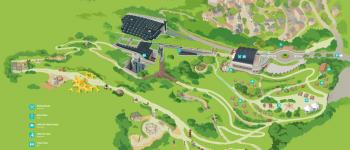
At the foot of Capdenac-Le-Haut, a superb village listed among “Les Plus Beaux Village de France” (The Most Beautiful Villages of France), the banks of the Lot Valley reveal an elegant town built in the 19th century: Capdenac-Gare in Aveyron.
Its urban architecture, typical of the industrial era, and its Art Deco aesthetic perfectly symbolize the transportation revolution and are distinguished by the development of businesses linked to the agri-food and aeronautics industries.
A bit of history...
Formerly part of the commune of Saint-Julien-d'Empare, it has been populated since at least the Gallo-Roman era.
Capdenac-Gare owes its birth to the creation of a railway station in the former commune of Saint-Julien-d'Empare in 1857, quickly becoming a hub for the entire southern Massif Central.
From a small railway hamlet, it became an urban center whose station, in its early days, was a major crossroads with five directions.
Capdenac Gare, city of railways...
In Capdenac, start by taking Avenue Albert Thomas, which features a row of villas, most of which were built before World War I. The materials used reflect the rise of industrialization. Richly decorated with earthenware, sculpted keystones, and cast iron railings, many of them also feature canopies supported by ornate ironwork, typical of bourgeois residences of the early 20th century.
In Capdenac-Gare, don't miss the Art Deco station and its tinted canopy, built in 1897. Also worth seeing is the Est steam locomotive 130-B-439, built by the Ateliers d'Épernay in 1883.
Among the curiosities is the Eiffel Bridge over the Lot, designed by Gustave Eiffel, and the Eiffel Tower, a 1/15 scale replica of the famous Parisian monument. The Capdenac Eiffel Tower is located in the Jardin de Fer as a tribute to the town's industrial history. It took its creator, Alain Lacombe, two years of work, 10 tons of iron, and 250 bolts to build this 28-meter-high replica.
Among the religious monuments, we can mention the Notre-Dame-des-Voyageurs church, built in a neo-Gothic style with contemporary stained glass windows by artist Marc Hénard and an unusual stained glass window depicting the train station and the railroad.
The church of Saint-Julien d'Empare, designed by Étienne-Joseph Boissonnade, architect of historic monuments, is also worth a visit.
Also worth seeing is the Massip Chapel, which periodically hosts exhibitions and visitors to highlight this important site of resistance during the Occupation.
No visit to Capdenac Gare would be complete without a visit to the Château du Saulou, in the center of the Empare plain. The stone corbels that once supported the machicolations are still visible on the former keep, now a dovecote, and bear witness to the ancient defensive structures of the 15th century. The spiral staircase in the round tower, the oldest part of the castle, dates back to the 11th century.
Also worth seeing is the Château de Saint-Julien d'Empare, built in the Middle Ages. Originally, it consisted of a central section between four corner towers, three of which still stand today. These towers still feature architectural elements that recall their fortified nature: corbels, arrow slits, etc. The structure was surrounded by moats, which have now been filled in, but some traces of which remain.
The octagonal bandstand, built around 1900, has columns made from railroad tracks.
Also worth seeing is the market hall, built in 1877 and inspired by the old Baltard market halls in Paris, which hosts a market every Saturday morning.
Finally, don't forget the old public baths, which still have outdoor fountains and a side entrance framed by columns decorated with mosaics.
In terms of gastronomy, Maison Raynal & Roquelaure is based in the town and sells more than 90 different ready-made meals from several production sites.
Capdenac-Gare Town Hall
1 avenue Albert Thomas – BP 29
12700 Capdenac-Gare
Tel.: 05 65 80 22 22
Translated with DeepL.com
(free version)





